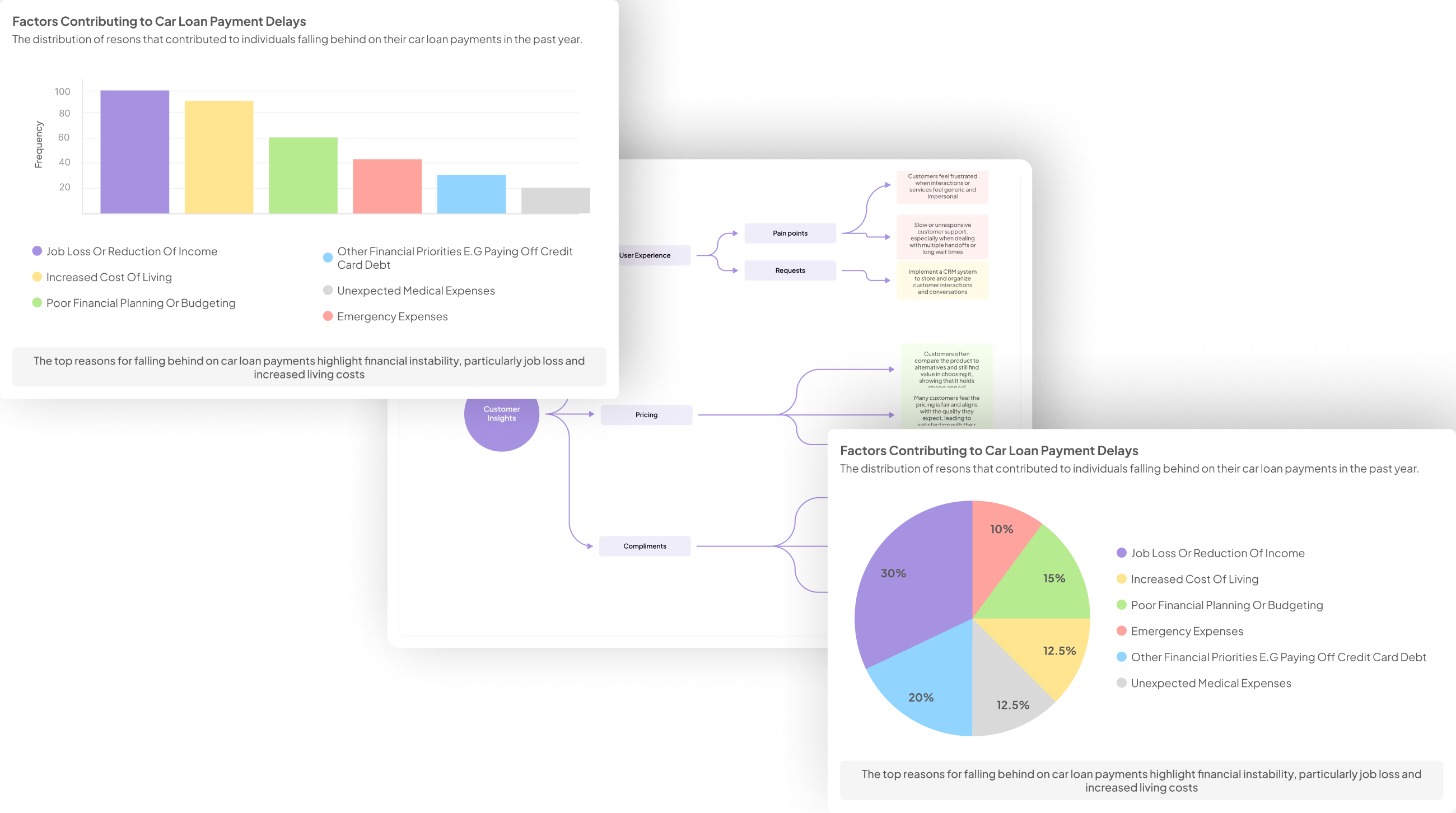How to Analyze Product Data
-
Bella Williams
- 10 min read
Product Data Analysis offers crucial insights that can transform a business's approach to product development and customer interaction. By carefully examining raw data collected from various sources, teams can unveil patterns and sentiments that significantly influence product decisions. This analytical process is vital for identifying what resonates with customers and what needs improvement.
In this section, we will explore foundational ideas surrounding Product Data Analysis, focusing on its significance in informing business strategies. Understanding how to gather, clean, and interpret product data forms the backbone of effective decision-making, ultimately leading to better products and enhanced customer satisfaction. Through this exploration, you'll learn actionable techniques to refine your analysis and elevate your product offerings.
Generate visualizations from your qualitative data. At Scale.

Understanding the Fundamentals of Product Data Analysis
Understanding the fundamentals of product data analysis is crucial for any successful product strategy. Product data analysis begins with the identification of data sources, which can include customer feedback, sales records, and product performance metrics. Each of these sources provides unique insights that, when combined, can paint a comprehensive picture of user experiences and market trends.
Next, it's important to recognize the various data types and formats you will encounter. This may range from quantitative data, such as sales figures, to qualitative data, like customer reviews. The ability to interpret these different types of data will empower you to draw meaningful conclusions. By mastering these fundamentals, you set the groundwork for more detailed analysis processes that enhance product quality and improve overall customer satisfaction. Ultimately, a solid understanding of product data analysis equips you to make informed decisions that drive product innovation and success.
Key Elements of Product Data
Understanding the key elements of product data is crucial for effective product data analysis. Identifying data sources is the first step, as accurate data collection begins here. These sources can include customer interactions, sales reports, and market research studies. Each source contributes unique insights that enhance understanding and decision-making in product development.
Next, it’s essential to recognize the various data types and formats that can be employed. Product data may come in structured formats like spreadsheets or databases, or unstructured forms such as customer feedback and social media comments. Analyzing these diverse data types allows businesses to draw comprehensive conclusions; linking qualitative insights with quantitative measurements enriches overall analysis. Ultimately, mastering these elements paves the way for more informed strategic actions and customer-oriented improvements that drive growth and satisfaction.
- Identifying Data Sources
Identifying data sources is a crucial step in product data analysis. In this phase, you gather information from various channels that influence your product's development and performance. Potential data sources include customer feedback, sales reports, market trends, and competitor analysis.
To maximize the value of your product data analysis, consider the following sources. First, customer feedback is invaluable; it provides direct insights into user experience and satisfaction. Second, sales reports offer empirical data on product performance over time. Third, monitoring market trends can reveal shifts in consumer preferences and emerging competitors. Lastly, competitor analysis helps you understand your product's positioning and potential areas for improvement. By systematically identifying and integrating these data sources, you can create a solid foundation for actionable insights that drive product success.
- Data Types and Formats
Product data comes in various types and formats, each serving distinct purposes in analysis. Understanding data types is crucial for deriving meaningful insights, as they influence the analysis outcomes. Common data types include numerical, categorical, and text data. Numerical data may represent sales figures, while categorical data could categorize products by type or brand. Text data, on the other hand, often emerges from customer reviews and feedback, offering qualitative insights that can drive product development.
Formats are equally important in product data analysis. Data can be structured, such as in databases, or unstructured, like emails and social media posts. Structured data is easily processed and analyzed using traditional methods. In contrast, unstructured data requires advanced analytical approaches to extract valuable insights. Therefore, recognizing the appropriate data types and formats is essential for effective product data analysis, guiding the analytical strategy and ultimately impacting decision-making.
Importance of Accurate Data
Accurate data serves as the backbone of effective product data analysis. When data is precise, it directly influences the quality of insights derived from it. Accurate insights help in establishing benchmarks that guide product development and refinement. This ensures that companies align their offerings with market demands and customer expectations. The ramifications of inaccuracies can be severe, leading to misguided strategies and lost opportunities in competitive markets.
It is essential to emphasize that the journey of product data analysis begins with integrity in data collection and management. Errors at this stage can skew analysis, ultimately impacting product quality and customer satisfaction. By placing importance on accuracy, businesses foster trust, not only in their methodologies but also in the decisions made based on the insights generated. Thus, prioritizing accurate data is crucial for deriving meaningful conclusions that drive product success and enhance customer experiences.
- Enhancing Product Quality
To enhance product quality, it is essential to prioritize the analysis of product data. Analyzing how customers interact with your product provides insights into improvements that can be made. Identifying patterns in customer feedback can lead to actionable changes, resulting in a product that meets or exceeds expectations.
Data analysis also helps in understanding market demands and performance benchmarks. By closely examining product data, businesses can pinpoint areas that require enhancement, ensuring that the product continuously aligns with customer needs. This approach not only elevates product quality but also fosters customer satisfaction and loyalty. Effective product data analysis transforms raw information into strategic actions, ultimately leading to a superior product offering.
Identify Key Metrics: Determine which performance indicators matter most to your product. Metrics could include defect rates, customer satisfaction scores, and return rates.
Collect Customer Feedback: Use surveys, interviews, and product reviews to gather direct insights from customers. This feedback serves as a foundation for understanding quality issues.
Analyze Historical Data: Look at past product performance to identify trends. Understanding the context can help you make informed predictions about future needs.
Implement Changes Based on Insights: Use the identified areas for improvement to develop an action plan. Implementing changes based on data can directly enhance the quality of the product over time.
Applying these steps enhances product quality through a structured approach to product data analysis.
- Improving Customer Satisfaction
Analyzing product data is essential for enhancing customer satisfaction. By understanding how customers perceive your products, you can identify key areas for improvement. Customers today expect personalized experiences and rapid responses to their needs. Utilizing product data analysis allows businesses to capture valuable feedback, enabling them to tailor solutions that resonate with their audience.
To effectively improve customer satisfaction, consider focusing on these essential aspects:
Listening to Customer Feedback: Regularly gather insights from customer interactions, which can reveal recurring issues or desires. This can help shape product development.
Identifying Trends: Analyze data to spot changes in customer preferences. Recognizing these trends helps stay ahead of the competition.
Implementing Changes Based on Insights: It is not enough to collect data; acting on those insights is crucial. Adjusting products or services in response to customer feedback demonstrates that you value their opinions.
By addressing these facets through product data analysis, businesses can cultivate deeper connections with customers, thereby enhancing their satisfaction levels.
Evaluate Performance on Customer Calls for Quality Assurance.
Steps in Product Data Analysis
Effective Product Data Analysis involves a series of structured steps that guide you through the process. The first step is the collection and cleaning of product data. Gathering relevant data means you should focus on key sources, ensuring the information is comprehensive and valid. Once collected, you must clean the data by removing duplicates and correcting inconsistencies. This allows for a more accurate analysis and reliable insights.
The next step is analyzing the product data for insights. Utilizing analytical tools, you can delve into the data to identify patterns and trends. Interpreting these data patterns provides a clearer picture of customer feedback and product performance. By following these steps, you will not only enhance your understanding of your product's strengths and weaknesses but also make informed decisions for future product development.
Step 1: Collection and Cleaning of Product Data
The first step in analyzing product data is crucial: it involves both collecting and cleaning the data. Gathering relevant data is paramount, as it forms the foundation for any analysis to follow. Begin by identifying diverse data sources, such as customer feedback, sales records, and product usage statistics. Collecting data from multiple sources enhances the richness of your analysis and can reveal deeper insights into consumer behavior.
Once the data is gathered, the focus shifts to cleaning it. This includes removing duplicates, correcting errors, and ensuring consistency across formats. By applying robust data cleaning techniques, such as outlier detection and standardization, you pave the way for accurate analysis. Clean data leads to more reliable insights, making it easier to understand trends and customer preferences. Taking these initial steps diligently enhances the overall effectiveness of your product data analysis process.
- Gathering Relevant Data
Gathering relevant data is a crucial first step in product data analysis. It involves identifying and extracting information from various sources that can shed light on customer preferences and product performance. Effective data collection ensures that you have a comprehensive view of the factors that influence your product's success. Consider engaging directly with customers to understand their needs and opinions, which can provide valuable insights that numbers alone may not reveal.
To streamline this process, focus on several key aspects: identify reliable data sources, choose the right data types, and be mindful of data formats. Reliable sources may include customer feedback, sales reports, and market research studies. Different data types, such as quantitative and qualitative, will enrich your analysis, providing both numerical insights and rich contextual information. Lastly, ensure that the data formats you use are compatible with your analytical tools for a seamless analysis experience. By gathering relevant data thoughtfully, you lay a solid foundation for robust product data analysis.
- Data Cleaning Techniques
Data cleaning is crucial in product data analysis, as it ensures the dataset is accurate and reliable. The primary goal of this process is to remove errors and inconsistencies that can mislead analysis results. Common data cleaning techniques include identifying and eliminating duplicates, correcting inaccuracies, and standardizing data formats. By employing these methods, you can enhance the integrity of the product data you are analyzing.
Another essential aspect of data cleaning is dealing with missing values. When datasets contain gaps, it is vital to decide whether to impute values, delete records, or keep them as is. The approach taken often depends on the significance of the missing data to your overall analysis. Furthermore, outliers should be assessed to determine if they are legitimate data points or anomalies that require exclusion. Hence, mastering these data cleaning techniques is foundational for deriving meaningful insights in product data analysis.
Step 2: Analyzing Product Data for Insights
In Step 2 of Product Data Analysis, we focus on delving into the collected data to extract valuable insights. The analytical process begins with selecting the right tools designed for data visualization and statistical analysis. These tools can help you explore various data patterns and trends, enabling you to answer critical questions about your product's performance and customer feedback.
Following the initial analysis, it’s crucial to interpret the results effectively. Identify key trends, such as common customer sentiments, both positive and negative. By categorizing this feedback, you can discern actionable insights that drive product improvements. Utilizing techniques like comparative analysis can also highlight disparities across different datasets. This way, you can make informed decisions that enhance product quality and ultimately improve customer satisfaction. Remember, the insights gathered here will be instrumental in guiding your product strategy moving forward.
- Using Analytical Tools
When it comes to using analytical tools for product data analysis, the objective is to extract actionable insights effectively. These tools can help visualize data trends, identify customer sentiments, and streamline the decision-making process. By employing advanced software solutions, organizations can quickly sift through large volumes of data, highlighting both positive and negative feedback. This allows teams to gain a clearer understanding of areas for improvement or innovation.
One effective approach is to use tools that facilitate comparative analysis. For instance, you can compare customer feedback across various demographics or regions. Utilizing features that allow querying your dataset in real-time can also enhance the analytical process. Whether identifying recurring themes or unique opinions, a systematic approach towards product data analysis can lead to well-informed strategic decisions, ultimately benefiting product development and customer satisfaction.
- Interpreting Data Patterns
Interpreting data patterns is a vital aspect of product data analysis. Recognizing these patterns can reveal significant insights into customer behavior, preferences, and potential issues that may affect product performance. By organizing data into manageable segments, such as monthly calls or specific user feedback sessions, analysts can spot trends that otherwise might remain hidden. This step also allows for a clearer understanding of recurring themes and customer sentiments.
A structured approach to interpreting data can involve several steps. First, it’s essential to aggregate and categorize the collected data. This could include identifying common pain points from customer interactions. Next, summarizing the findings into digestible formats, such as charts or reports, helps visualize trends and themes effectively. Finally, consistently asking relevant questions throughout the analysis will further illuminate valuable insights. Engaging in this systematic process ensures that product data analysis yields actionable results.
Conclusion: Final Thoughts on Product Data Analysis
In conclusion, effective Product Data Analysis is vital for driving informed decisions. It empowers businesses to refine products based on customer feedback and market trends. When data is collected meticulously, the resulting insights can reveal essential patterns that might otherwise go unnoticed. This understanding fosters an environment where products can continually improve, aligning more closely with customer expectations.
Additionally, leveraging analytical tools enhances the ability to interpret data accurately. By engaging in thoughtful analysis, organizations can adapt strategies that meet market demands. Ultimately, embracing a structured approach to Product Data Analysis lays the foundation for sustained growth and innovation in today’s competitive landscape.







